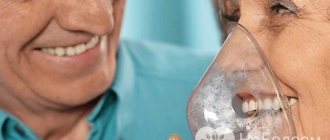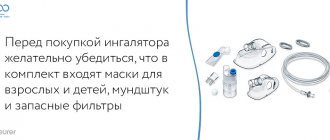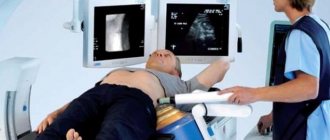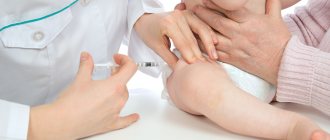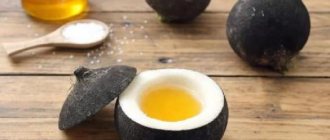What is a nebulizer used for?
Enlarge
A nebulizer is a modern inhaler that allows you to obtain a very fine aerosol with a drug. Everyone knows, for example, a “homemade” inhaler - boiled potatoes in a pan covered with a towel.
So, when inhaling the steam formed over potatoes, it only affects the upper parts of the respiratory tract, because the droplets are quite large in size and settle quickly. When using a nebulizer, the aerosol droplets are so small that they penetrate into the lowest parts of the lungs and there they exert their therapeutic effect.
Therefore, the main purpose of using nebulizers is to treat respiratory diseases throughout. Such diseases include bronchitis, tracheitis, laryngitis, pneumonia, sinusitis, and influenza.
For what cough can inhalations be used?
This treatment can be recommended for adults and children with dry cough caused by the following diseases of the respiratory system: acute respiratory infections, laryngitis, bronchitis, tracheitis, pharyngitis. Often, patients in the final stages of pneumonia develop a cough, for the treatment of which inhalation is also recommended.
To moisturize the mucous membranes of the respiratory system and relieve swelling during a dry cough, inhalations are prescribed. During this procedure, the formation of sputum is accelerated, which allows you to convert a dry (non-productive) cough into a wet (productive) one. [2] Thanks to inhalation, it is possible to avoid such a dangerous complication as blockage of the airways, because this manipulation eliminates the narrowing of the larynx.
It is important to remember the following rules when performing inhalations:
- Take inhalations at least an hour before meals.
- In the first 60 minutes after the procedure, it is not recommended to talk, sing, drink or eat.
- When you have a runny nose, it is recommended to breathe only through your nose, and during cough inhalations, you need to inhale through your mouth and exhale through your nose.
- Completely exclude the possibility of combining oil inhalations with steam inhalations.
- The recommended duration of one manipulation is from 5 to 15 minutes.
- Carry out inhalations in courses of ten procedures.
- Important: use only those products prescribed by your doctor. It is always necessary to monitor the accuracy of the dosage of the drug and the concentration of the herbal decoction. [3]
- Body position should not interfere with the free process of breathing during inhalation.
- During the procedure, it is recommended to wear the most comfortable and loose clothing that will not constrain the patient.
Experts say
At the moment, the best way to treat acute respiratory infections is nebulizers. With their help, you can deliver the necessary medications directly to the site of inflammation - to the bronchi, trachea. It is recommended to start doing inhalations with a nebulizer at a temperature and the first signs of acute respiratory infections - coughing, runny nose, sneezing.
Nebulizers are especially effective in children: their bronchi have a small lumen and, when inflamed, quickly become clogged with the resulting sputum.
Therefore, the answer to the question: is it possible to do inhalation with a nebulizer in children at high temperatures (for example, 38 degrees or more) is definitely positive. The effect is observed literally within the first minutes after inhalation: sputum begins to disappear, a wet cough appears, the condition improves, and after a while the temperature begins to decrease.
In this case, medications administered through a nebulizer are used in such low dosages that they do not have any systemic effect on the human body.
Is it possible to do inhalations with a nebulizer at a fever? Can! Inhalations with this device at a temperature can be used not only for acute respiratory infections, but also for other acute and chronic lung diseases in adults and children, for example, pneumonia, exacerbations of chronic bronchitis, cystic fibrosis. In all cases, there is a reduction in the duration of the temperature period, a rapid improvement in well-being, accelerated recovery, and a reduced need for medication.
The use of inhalations for children - when to do it, process technology, features of the procedure
Treating colds in children is a troublesome task, but if you use not only modern medications, but also well-known, proven methods, you can significantly simplify this process.
The use of inhalations for children during colds has always been considered justified - both traditional medicine and official scientists approve of such procedures, and such unanimity is rare. Parents must understand that inhalation is a medical procedure, so it must be carried out in compliance with certain rules.
What to do with inhalation for a wet cough
If the diagnosis is confirmed, the patient needs inhalation treatment, the following drugs are prescribed.
Mucolytics
The choice of medicines is great. The drugs are sold in pharmacies without a prescription. Price from 50 rub. Mucolytics are necessarily part of the complex treatment of diseases accompanied by mucus accumulation. Medicines thin sputum, increase cough syndrome, and stimulate the removal of mucus from the body. For children and adults, experts most often prescribe:
- Mukolwan;
- Ambrobene;
- Ambroxol;
- Lazolvan;
- Pulmozyme;
- Fluimucil.
Immediately before use, the selected drug is diluted with saline solution. Up to 5 ml of the prepared solution is poured into the nebulizer bowl. Inhale the medicine for 5-10 minutes twice a day - morning, evening.
Bronchodilators
The drugs act on the smooth muscles of the bronchi and lungs, improving their functioning. Used for difficulty breathing and severe coughing attacks. Additionally, they have a mild expectorant effect. For a wet cough, the following is most often poured into a nebulizer:
- Ventolin Nebula;
- Salbutamol;
- Astalin;
- Salgim;
- Berotek;
- Berodual;
- Atrovent.
Bronchodilators do not treat, but eliminate symptoms, therefore they are used in combination with mucolytics and hormonal agents.
Anti-inflammatory drugs
Hormonal agents based on glucocorticosteroids quickly stop the inflammatory process, eliminate tissue swelling, and reduce the activity of histamines. The dosage is selected individually depending on the severity of the disease and the age of the patient. The duration of therapy is controlled by a specialist. At home, medications are used after consultation. Often prescribed:
- Pulmicort;
- Cromohexal;
- Budenit;
- Tafen Nazal.
Antibiotics also relieve inflammation. Medicines destroy pathogenic microflora and stop the pathological process. Fluimicil-Antibiotic is prescribed by inhalation.
Recommendations for inhalations
Inhalation with a spray for wet cough should be carried out according to the instructions for use of the drug.
Inhalations for wet coughs can increase the therapeutic effect of other medications.
Contraindications to inhalation for wet cough:
- purulent process in the organs of the respiratory system;
- the presence of blood in the mucus discharge;
- pneumothorax;
- emphysema;
- tendency to develop nasal and/or pulmonary bleeding;
- neoplasms in the respiratory tract and/or brain;
- history of severe cardiovascular diseases.
Inhalations can be hot (the temperature of the inhalation agent is above room temperature) and cold (the temperature of the solution is not above room temperature). During hot inhalations, you should not breathe over a boiling solution, since a burn to the respiratory tract will only aggravate the course of the disease. Typically, it is recommended to cool the solution for steam inhalation to 50-65 °C. Hot inhalations are not carried out at elevated temperatures. Cold inhalations can be performed at elevated body temperatures.
The solution for steam inhalation should not be scalding
Before inhalation, you need to make sure that the patient is not allergic to the active substance.
During inhalation you should not talk or engage in any other activity. For each procedure, you need to prepare a fresh solution. Inhalation should be done 1-2 hours before or the same time after meals.
After the procedure, you need to rinse your mouth with water and wash your face to remove any remaining solution. It is not recommended to go outside for 1-2 hours after inhalation.
If the cough intensifies after inhalation, the cause may be incorrect selection of the drug, individual intolerance to the components of the solution, or incorrect sequence of use of drugs in complex treatment. If the patient's condition worsens during or after inhalation, you should stop treatment and seek medical help.
Prevention of bronchitis in children
The issue of preventing bronchitis in children is especially acute, because a child’s body, with a fragile immune system, is constantly at risk. Especially when visiting a kindergarten or school.
General prevention, available to everyone, should be limited to strengthening the child’s immunity; for this, the following measures are used:
- Light hardening is quite reasonable after a year;
- Ventilation of premises;
- Walks in the open air;
- Eating quality food, including vegetables and fruits;
- Maintaining humidity in the sleeping area;
- Protection from disease-provoking factors - tobacco smoke, dust and various chemicals in the air;
- Physical activity.
In addition to the treatment of bronchitis in children, IRS® is also used for preventive purposes, especially during the period of colds. If you start preventive measures in advance, a protective barrier is formed against most types of respiratory infections. The preventive course is two weeks, the effect can last 3-4 months, which is very important in autumn and winter10. The use of IRS®19 is possible from three months of life6.
Wet cough due to ARVI in children - what to do?
If a child has characteristic symptoms of ARVI (fever, headache, sore throat, redness of the throat, nasal congestion, runny nose), specific treatment for a productive cough is not carried out. A normally functioning immune system is able to cope with this symptom on its own as it recovers. To help her and speed up the process, you must follow the following rules:
- In the child’s room, optimal temperature (18–20 °C) and humidity (50–60%) should be maintained. It is recommended to regularly ventilate the room, carry out wet cleaning 2-3 times a day, refuse to use heaters and, if necessary, use household humidifiers;
- a prerequisite necessary to cure a child’s severe wet cough is plenty of warm drink (still mineral water, vitamin fruit drinks, herbal teas, milk with honey, etc.). Strict adherence to this recommendation facilitates the removal of sputum, and with it the toxic waste products of the virus;
- If the cause of the cough is mucous nasal secretion flowing down the back wall of the nasopharynx, then for its normal discharge at night and in the morning, experts recommend rinsing the child’s nose with saline solution or irrigating the walls of the nasal cavity with a special nasal spray for children. The condition will be alleviated by raising the pillow higher;
- adherence to strict bed rest during the treatment of ARVI is not necessary (moderate physical activity can significantly facilitate the discharge of sputum);
- Doctor MOM® Phyto ointment can be used as an external remedy for colds in children. This drug contains essential oils of 4 medicinal plants.
At normal body temperature, in addition to the above methods, the child is allowed to do a light percussion massage (gently tapping the back in the lung area with fingertips) to relieve expectoration. To quickly cure a wet cough in a child, one should not forget how beneficial walking outside is ( naturally, if he does not have a high temperature). Fresh air entering the lungs promotes deeper breathing and stimulates the liquefaction and removal of accumulated mucus. An increase in productive cough during a walk is a completely normal phenomenon, due to increased blood supply to the bronchial mucosa and activation of the secretory glands.
Inhalations for wet cough in adults
The main indication for inhalation therapy is the presence of mucus in the bronchi and lungs, and difficulty in clearing it. A nebulizer should not be used without airway obstruction. Treatment begins after confirmation of the diagnosis and consultation with a specialist. An inhaler is not needed for a wet cough if the mucus is coughed up well.
For complex bronchitis and pneumonia, doctors prescribe medications with:
- anti-inflammatory;
- mucolytic;
- decongestant;
- bronchodilator property.
Additionally, inhalations may be prescribed for coughs with sputum with an immunostimulating effect. The breathing procedure lasts 5-10 minutes. The course of treatment is 3-10 days.
Causes of bronchitis in children
As in adults, bronchitis in children develops mainly due to a viral infection. In the summer the child gains strength, but in the fall, winter and spring he gets sick very often. This is a common picture, especially if the child goes to kindergarten or an educational institution. The child’s body is attacked by the following viruses:
- influenza types A, B, C and parainfluenza;
- adeno- and rhinoviruses;
- corona virus
- respiratory syncytial virus
- metapneumovirus
Much less often than viruses, but much more often than in adults, bacterial infections become the cause of bronchitis in young children:
- the causative agent of whooping cough (bordetella);
- chlamydia;
- mycoplasma;
- staphylococci;
- pneumococci;
- streptococci.
Wet cough in a child with bronchitis
If the child’s temperature has already dropped, but there is still apathy, weakness, pale skin and painful coughing attacks (both productive and non-productive), there may be an inflammatory process and the development of complications (bronchitis or pneumonia). In this situation, to confirm or refute the diagnosis, the help of a specialist is required, who will prescribe the necessary studies and give appropriate recommendations for treatment. Attention! Antibiotics should only be taken with the permission and supervision of a physician. Independent choice of antibacterial agents for a child, due to the presence of a large number of contraindications, is strictly prohibited!
What should I give my child for a wet cough?
In some cases, experts recommend taking expectorants as a means of additional treatment for wet children's cough. Among the wide variety of cough remedies, one should highlight Doctor MOM® syrup, made on the basis of plant extracts. It can not only cleanse the bronchi from accumulated pathological mucus, but also have an anti-inflammatory effect. Please note! Taking an expectorant does not negate the need to use other therapeutic factors - regular ventilation, maintaining optimal temperature and humidity in the room, plenty of warm drinks, etc. As for treating a wet cough in a child with folk remedies, it is permissible only after prior consultation with a specialist .
Features of acute and chronic bronchitis in children
In most cases, doctors cope with the treatment of acute bronchitis in children. If after four weeks the child continues to cough, then the diagnosis is changed to prolonged bronchitis. This condition continues for up to several months.
The main danger of the acute form lies in the consequences and complications of bronchitis in children. The risk of developing chronic bronchitis or pneumonia has already been discussed. It is also possible to develop into obstructive bronchitis, in which problems with breathing itself begin due to swelling and spasm. Respiratory failure, shortness of breath develops, it becomes difficult to breathe, which poses a real threat to life, especially if the child is still small and can hardly explain his feelings. In this case, you should consult a doctor as soon as possible, and if your condition suddenly worsens or there is severe breathing restriction, you should immediately call an ambulance5.
Pediatricians successfully treat acute bronchitis in children, but the chronic form is more difficult. It is quite difficult to detect it in a child, because officially, the diagnosis is made after at least two years.
To identify the chronic form, additional diagnostics, observations, and anamnesis (questioning) may be required from parents. By comparing all the data and observations, the doctor can make the correct diagnosis.
When identifying a chronic form, it is important to promptly notice exacerbations of the disease, as well as its remission (subsidence). When a child’s body experiences another attack, the following symptoms of intoxication appear:
- Headache, weakness occurs, general health worsens;
- Increased sweating, especially at night;
- Feeling constantly tired;
- Your temperature may rise.
When remission occurs, all symptoms go away, like the cough itself5.
Recently, the terminology of chronic bronchitis in children has generated controversy in the medical community. In adults, the impetus for the formation of a chronic disease is smoking or work associated with hazardous chemical or mechanical production (for example, miners). For obvious reasons, this cannot apply to a child. However, chronic bronchitis occurs quite often in children.
Children are also more likely to suffer from bacterial infections. This may be due to the fact that immunity is still poorly formed at an early age. Any acute respiratory disease opens up access to bacterial infection; the immune system simply does not have time to react, as it is busy with a viral infection2.
